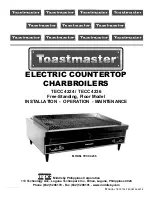
27
3-3
+
+
3
12
1
P1
2
P3
INS
TALLER
US
ER
MAINTEN
AN
CE TECHNI
CI
AN
3.3 TROUBLESHOOTING.
N.B.:
maintenance operations must be carried
out by an authorised company (e.g. Authorised
After-Sales Technical Assistance Service).
- Smell of gas. Caused by leakage from gas circuit
pipelines. Check sealing efficiency of gas intake
circuit.
- Repeated ignition blocks. It can be caused by
no gas, check the presence of pressure in the
network and that the gas adduction cock is
open. Incorrect adjustment of the gas cock,
check the correct calibration of the gas valve.
- Irregular combustion or noisiness. It may be
caused by: a dirty burner, incorrect combustion
parameters, intake-exhaust terminal not cor-
rectly installed. Clean the above components
and ensure correct installation of the terminal,
check correct setting of the gas valve (Off-Set
setting) and correct percentage of CO
2
in flue
gas.
- Frequent interventions of the overheating
safety thermostat. It can depend on the lack
of water in the boiler, little water circulation
in the system or blocked pump. Check on the
manometer that the system pressure is within
established limits. Check that the radiator
valves are not closed and also the functionality
of the pump.
- Drain trap clogged. This may be caused by
dirt or combustion products deposited inside.
Check, by means of the condensate drain cap,
that there are no residues of material blocking
the flow of condensate.
- Heat exchanger clogged. This may be caused
by the drain trap being blocked. Check, by
means of the condensate drain cap, that there
are no residues of material blocking the flow of
condensate.
- Noise due to air in the system. Check opening
of the special air vent valve cap (Fig. 1-30).
Make sure the system pressure and expansion
vessel pre-charge values are within the set
limits; The factory-set pressure values of the
expansion vessel must be 1.0 bar, the value of
system pressure must be between 1 and 1.2 bar.
- Noise due to air inside the condensation mod-
ule. Use the manual air vent valve (Fig. 1-30)
to eliminate any air present in the condensa-
tion module. When the operation has been
performed, close the manual vent valve.
3.4 CONVERTING THE BOILER TO
OTHER TYPES OF GAS.
If the boiler has to be converted to a different
gas type to that specified on the data nameplate,
request the relative conversion kit for quick and
easy conversion.
The gas conversion operation must be carried
out by an authorised company (e.g. Authorised
After-Sales Technical Assistance Service).
To convert to another type of gas the following
operations are required:
- disconnect the appliance;
- replace the nozzle located between the gas pipe
and gas/air mixing sleeve (Part. 8 Fig. 1-30),
taking care to disconnect the appliance during
this operation;
- re-power the appliance;
- calibrate the number of fan revolutions (parag.
3.5):
- adjust the correct air/gas ratio (parag. 3.6);
- seal the gas flow rate regulation devices (if set-
tings are modified);
- after completing the conversion, apply the
sticker, contained in the conversion kit, near
the data nameplate. Using an indelible marker
pen, delete the data relative to the old type of
gas.
These adjustments must be made with reference
to the type of gas used, following that given in
the table (Par. 3.18).
3.5 CALIBRATION OF NUMBER OF FAN
REVS.
Attention:
verification and calibration is neces-
sary, in the case of transformation to other types
of gas, in the extraordinary maintenance phase
with replacement of the PCB air/gas circuit com-
ponents or in the case of installations with flue
extraction systems, with horizontal concentric
pipe measuring more than 1 metre.
The boiler heat output is correlated to the length
of the air intake and flue exhaust pipes. This
decreases with the increase of pipe length. The
boiler leaves the factory adjusted for minimum
pipe length (1m). It is therefore necessary, espe-
cially in the case of maximum pipe extension, to
check the ∆p gas values after at least 5 minutes
of the burner operating at nominal heat output,
when the temperatures of the intake air and ex-
haust flue gas have stabilised. Adjust the nominal
and minimum heat output in the domestic hot
water and central heating modes according to
the values in the table (Par. 3.18) using the dif-
ferential manometers connected to the ∆p gas
pressure points (16 and 17 Fig. 1-30).
Enter the configurations menu and regulate the
following parameters (Par. 3.8):
- minimum DHW power output;
- maximum DHW power output;
- minimum central heating output;
- maximum central heating output;
- Ignition power.
Key:
1 - Gas valve inlet pressure point
2 - Gas valve outlet pressure point
3 - Off/Set adjustment screw
12 - Outlet gas flow rate regulator
Gas Valve 848














































